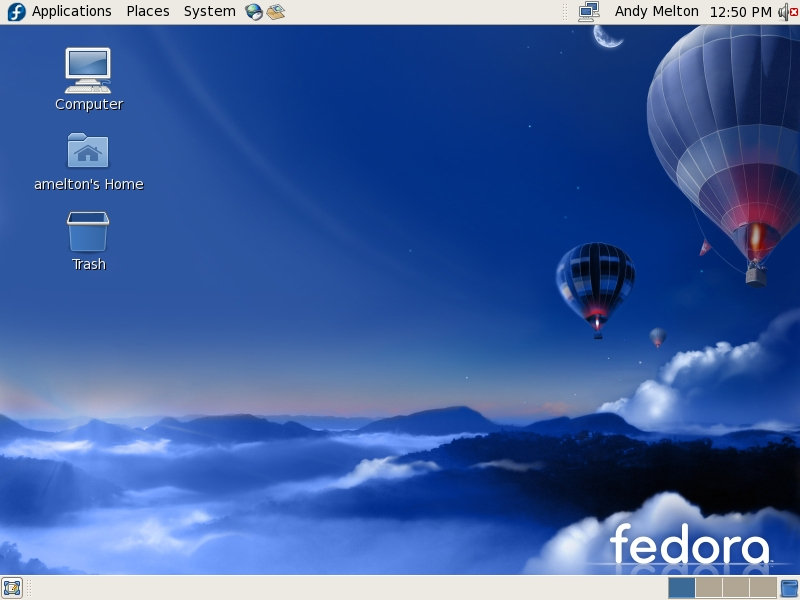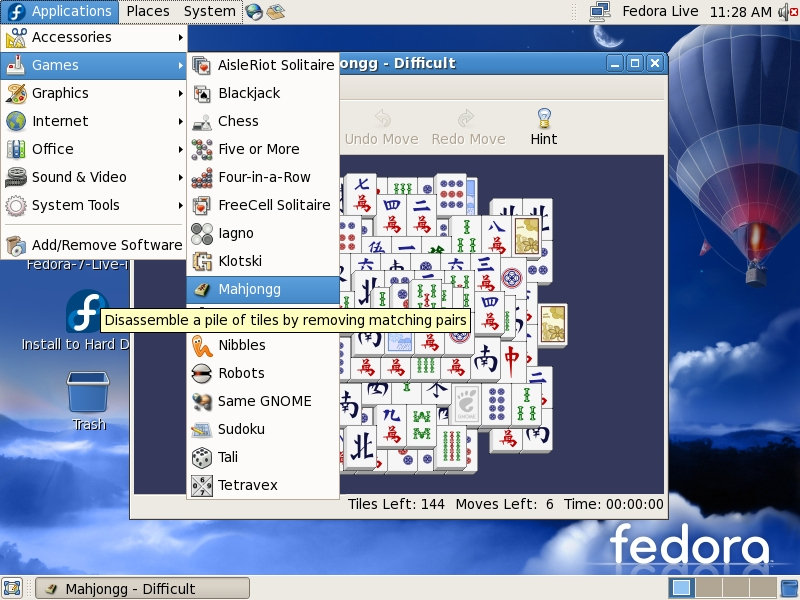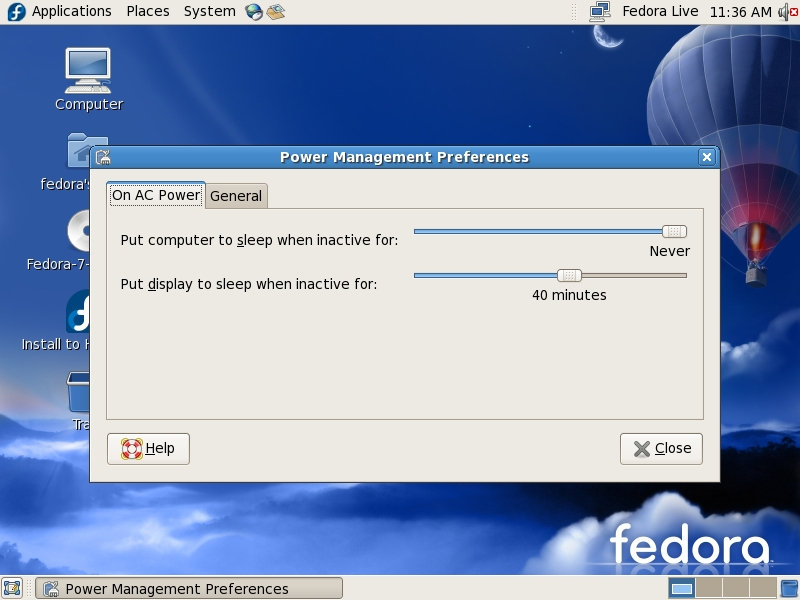Finally after many months of it being available I am able to sit down and install the latest version of Fedora, not Fedora Core, simply Fedora. The Fedora group decided to ditch the “Core” and “Extras” versions of Fedora and focus their attention on one version. I think it’s a great idea because it’s a lot less confusing.

The other day I was able to run the LiveCD of Fedora 7 and I was extremely impressed with it’s speed. Earlier this year was the last time I had Fedora installed directly onto my computer. I later removed it because I was unable to get my video card to work. I hope that is something that I can get to work this time. Since then I’ve been using Fedora in a virtual environment. I have several projects coming that will require as much performance as I can get and I’d like to have Fedora installed directly onto the computer so I can get that performance. If the LiveCD is any indication of the performance of the latest version, I think I will be happy, at least I hope so.
Installation
The installation is a fairly standard affair. Not a whole lot has changed, just new graphics in the graphical installer. I had to reboot the installation wizard once when I was configuring my hard drive partitions. I hope that isn’t an indication that I’m going to have problems. Also, hard drives are no longer recognized as “hda1”, “hda2”, they are now recognized as SCSI drives and are labeled “sda1”, “sda2” and so on. The rest of the wizard is pretty much the same as it was in Fedora Core 5 & 6. There aren’t any new applications to report in the applications section of the installation wizard, none that I can tell other than the name change of “GAIM” to “Pidgin.”
The installation of Fedora 7 went pretty quickly, I didn’t have it install anything other than the standard packages. When you reboot and get to the “First Boot” configuration wizard there is a new section that allows you to send a profile of your hardware to the Fedora developers. I highly recommend doing this so they can make Fedora run on more hardware and better.
I am pleased with the installation of Fedora. I am very pleased that I did not have a headache to deal with as far as the video card goes. I am disappointed in that the drivers that were used do not allow me to enable the fancy desktop effects. Although I prefer Fedora, I think this is something that Ubuntu has done a really nice job of. The last time I had Ubuntu on my system it asked me if I wanted to install non-supported drivers for my graphics card, which I did, once I had installed them I was able to use Beryl. I am sure I could install the proper Nvidia drivers on Fedora and I might sometime, but I don’t want to break my system, just yet.
I was also pleased when I rebooted out of Linux and back into Windows and did not receive any error messages. This is usually the case but you never know what might happen with a new version.
Speed of Fedora 7
As I mentioned previously, I ran the Fedora 7 Live CD the other day and was extremely impressed by the speed of the Live CD. Normally Live CD’s are pretty slow. I am pleased to note that Fedora 7 is just as speedy when installed directly onto the computer. It definitely feels a lot faster than Fedora Core 5 & 6.
I also feel as though browsing the Internet is significantly faster. I’ve always felt as though browsing the Internet on Linux, any distribution, is faster than browsing the Internet on Windows or the Mac but it feels even faster on Fedora 7. My video blog seems to just pop right up, but on Windows it takes several seconds for everything to fully load.
Fast User Switching
A new feature in Fedora 7 is fast user switching. This is something that has been available in other distributions for a long time now and it’s nice to see in Fedora.
Package Manager
Once you get Fedora installed you can add more applications by clicking the “Add/Remove Software” menu item under “Applications.” There are a whole lot more applications available once you get Fedora installed. The reason they do this is that they can’t include everything on the DVD so once you get the system installed you can choose to install them then, but you’ll have to be connected to the Internet to do it. There are a lot of things to choose from, games, educational tools, engineering and scientific software. Some of the applications may look confusing, just read the description and it will usually explain what it is.

The “Add/Remove” software isn’t a new feature of Fedora, it’s been there for a long time. What is new are some of the applications that you can now get by using this tool, some of the more popular applications include: Democracy (now called Miro), Rosegarden, and aMSN. I’m sure there are more applications that are new but those are the more popular ones that I recognized. In the Servers section there is now an option for a Clustering server.
One thing to note is that everytime I would go to the Servers section some of the servers would be check marked even though I did not choose them anywhere else and none of the selections I made would require those to be installed.
Power Management
With both Ubuntu and Fedora I have been happy to see that when I have Linux installed directly on my hardware it recognizes my APC battery backup. All of the configuration options are comparable to that of what you get with the Windows software. The only thing that you don’t get is the software does not send information back to APC about the utility company in your area.

A cool feature of the power management software is the Power History charts. At the moment there isn’t anything on my chart due to the fact that I haven’t been running Fedora around the clock. I think it would be an interesting graph to look at though.
My Wishlist
The first thing I’d like to see in an upcoming update or the next version of Fedora is a way to very easily mount FAT & NTFS hard drives. Ubuntu can do it and I think the Fedora developers should be able to easily implement this. I know it’s simple to do it via command line but it would be even simpler to just double click an icon in the “Computer” window.
Secondly. Whenever you open an administration dialog in Fedora 7, you have to enter your password every single time you open one. In older versions of Fedora and RedHat you could enter your password once and the password would remain active for a few minutes so you could open several dialogs without having to enter your password every single time. After a few minutes had went by and you were finished with the admin dialogs and opened another one you had to enter your password again, which wasn’t as annoying as having to enter it every single time.
Conclusion
Fedora 7 is a great update and I feel as though it is a much needed update. Everything feels a lot fresher with the better looking graphics. Everything works “out of the box” so to speak. I didn’t have any issues getting a GUI on my screen as I did with Fedora Core 6, that I am very pleased with. I’m not pleased with the fact that the driver that was installed isn’t one that is compatible with the desktop effects. However, I do understand that the driver that was installed was an open source driver and not one from Nvidia. I’m sure the open source community will continue to make the open source driver even better.
I am also extremely pleased with the responsiveness of the system. It feels a lot faster, a lot more crisp. I don’t see jagged edges whenever a menu item drops down. I think the developers done an amazing job with this release and I hope that Fedora 8 will be even better.
Now, with that said I have to point out that I think Ubuntu has got Fedora beat in some aspects. I think when it comes to packages there are a ton more packages that are much more easily installed with Ubuntu. In Ubuntu you can use the package manager to install non-supported software and drivers which drastically improve the systems usefulness. Also, now that Dell has taken on Ubuntu as one of the operating systems they are offering on their computer lineup, more people are going to be using Ubuntu and there is going to be even more development going into it. That means: better drivers, better looks, more software.
Now, as a long time RedHat/Fedora user, with the above said I have to say that I’m still partial to Fedora. I primarily use Fedora as a server. I also prefer Fedora because of the RedHat underpinnings. I’m more familiar with that environment and prefer it. I think it’s a great operating system, especially for servers. On the desktop side of things, it has some catching up to do. However, don’t let what I’ve said in the past couple of paragraphs negate the fact that I think Fedora 7 is a great release.